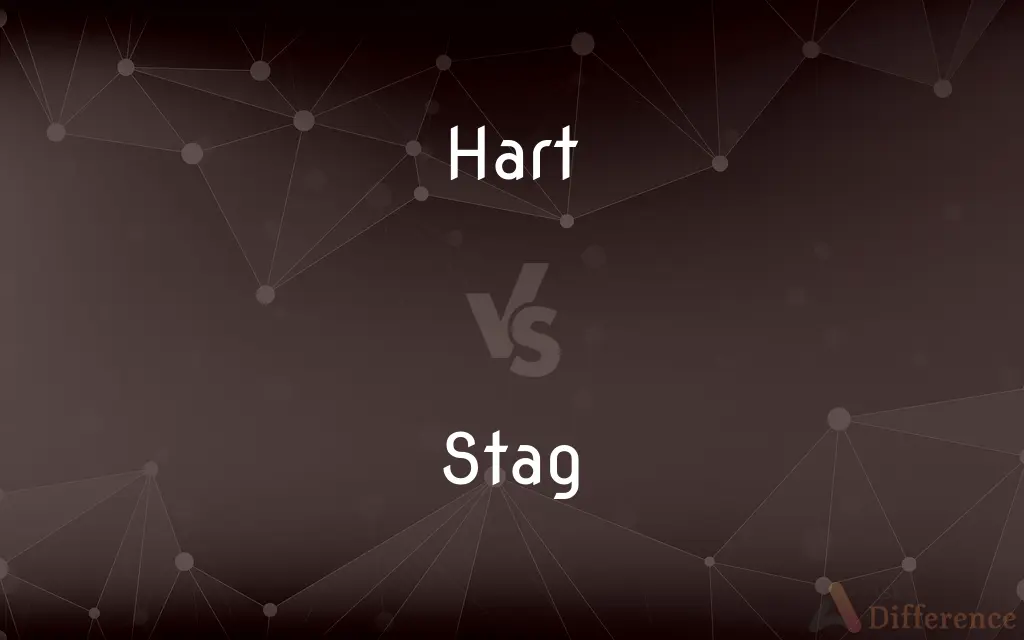Hart vs. Stag — What's the Difference?
By Maham Liaqat & Urooj Arif — Updated on April 24, 2024
A hart is a mature male deer, typically over five years old, often specifically a red deer, while a stag is a general term for male deer of various species.

Difference Between Hart and Stag
Table of Contents
ADVERTISEMENT
Key Differences
A hart is an old English term primarily used to describe a mature male red deer, particularly one that is five years old or older. In contrast, a stag is a more broadly used term applicable to adult male deer of any species, including red deer, elk, and others.
The term "hart" is often associated with medieval hunting traditions and heraldry, emphasizing its historical and cultural significance. On the other hand, "stag" is commonly used in contemporary contexts, ranging from wildlife biology to casual conversation.
The hart is celebrated in literature and folklore for its majesty and strength, often symbolizing nobility and virility. Whereas stags are frequently featured in modern media and discussions about wildlife, emphasizing their role in nature and as game animals.
Harts, due to their age, typically exhibit larger and more developed antlers than younger deer. Meanwhile, the antlers of a stag can vary widely depending on the species and the individual's age and health.
In terms of behavior, harts, given their age and size, are usually more dominant within deer herds. Stags, depending on their species and environment, might display varying degrees of dominance and territorial behavior.
ADVERTISEMENT
Comparison Chart
Age
Typically over five years old
Adult male of any age
Species
Mainly red deer
Various species, including red deer, elk
Cultural Significance
High, with historical and heraldic value
Broadly recognized in modern contexts
Symbolism
Nobility, virility
Nature, wilderness, game animal
Antler Development
Larger and more developed due to age
Varies by age, health, and species
Compare with Definitions
Hart
A term used in old English and literary contexts.
Poets often praised the hart for its grace and strength.
Stag
A male deer of any species.
A stag was spotted leading the group across the river.
Hart
Known for large, well-developed antlers.
The old hart displayed his impressive antlers during the rut.
Stag
Used universally across various English-speaking cultures.
Stag parties are named for their association with male bonding.
Hart
A mature male red deer, especially over five years old.
The hart stood majestically at the edge of the forest.
Stag
Commonly referred to in discussions of wildlife and hunting.
Hunters often seek stags for their prized antlers.
Hart
Historically significant in European tradition.
The king's men hunted the hart in the royal forest.
Stag
Antler size and shape vary across species and individuals.
The young stag's antlers were just beginning to branch.
Hart
Symbolic in medieval heraldry and literature.
The family crest featured a hart to symbolize courage.
Stag
Featured in modern media and wildlife documentaries.
The documentary highlighted the life cycle of a stag.
Hart
A male deer, especially a male red deer over five years old.
Stag
A person who attends a social gathering unaccompanied by a partner, especially a man who is unaccompanied by a woman.
Hart
A male deer, especially the male of the red deer after his fifth year.
Stag
A social gathering for men only.
Hart
A male red deer or one of related species.
Stag
Of or for men only
A stag party.
Hart
Obsolete spelling of heart
Stag
Pornographic
Stag films.
Hart
A stag; the male of the red deer. See the Note under Buck.
Goodliest of all the forest, hart and hind.
Stag
Unaccompanied
Went to the dance stag.
Hart
United States playwright who collaborated with George S. Kaufman (1904-1961)
Stag
To attend a social gathering unaccompanied by a partner. Used especially of men.
Hart
United States lyricist who collaborated with Richard Rodgers (1895-1943)
Stag
(countable) A colt, or filly.
Hart
Male red deer
Stag
A romping girl; a tomboy.
Stag
(countable) An improperly or late castrated bull or ram – also called a bull seg (see note under ox).
Stag
An outside irregular dealer in stocks, who is not a member of the exchange.
Stag
One who applies for the allotment of shares in new projects, with a view to sell immediately at a premium, and not to hold the stock.
Stag
An unmarried man; a bachelor; a man not accompanying a woman at a social event.
A stag dance; a stag party; a stag bar
Stag
(countable) A social event for men held in honor of a groom on the eve of his wedding, attended by male friends of the groom; sometimes a fundraiser.
The stag will be held in the hotel's ballroom.
Stag
Guard duty.
Stag
(countable) A stag beetle (family Lucanidae).
Stag
(countable) The Eurasian wren, Troglodytes troglodytes.
Stag
To act as a "stag", an irregular dealer in stocks.
Stag
(transitive) To watch; to dog, or keep track of.
Stag
Of a man, attending a formal social function without a date.
My brother went stag to prom because he couldn't find a date.
Stag
A colt, or filly; also, a romping girl.
Stag
A castrated bull; - called also bull stag, and bull seg. See the Note under Ox.
Stag
An outside irregular dealer in stocks, who is not a member of the exchange.
Stag
The European wren.
Stag
To act as a "stag," or irregular dealer in stocks.
Stag
To watch; to dog, or keep track of.
Stag
Male red deer
Stag
Attend a dance or a party without a female companion
Stag
Give away information about somebody;
He told on his classmate who had cheated on the exam
Common Curiosities
Can the term "stag" apply to any deer species?
Yes, "stag" is a general term used for adult male deer of any species.
Why is the term "hart" less common today?
"Hart" is an archaic term with roots in medieval English and is less common in modern language, which favors "stag."
What distinguishes a hart from other male deer?
A hart specifically refers to a mature male red deer over five years old.
What cultural significance does a hart have?
The hart has historical significance in medieval hunting and heraldry, often symbolizing nobility.
Which term is more appropriate when referring to deer in a biological context?
"Stag" is more appropriate and universally understood in biological and ecological discussions.
How are the antlers of a hart different from those of a younger stag?
The antlers of a hart are typically larger and more developed due to the deer's age and maturity.
Do harts and stags have different roles within deer herds?
Typically, both harts and stags can play dominant roles, but the specific dynamics depend on the species and individual.
Is there a difference in the usage of "hart" and "stag" in literature?
"Hart" is often used in historical and literary contexts, while "stag" is more common in contemporary writing.
What symbolic meanings are associated with stags?
Stags are often symbols of nature, wilderness, and virility.
How does the public perception of harts and stags differ?
The hart is often viewed with a sense of historical and cultural reverence, while the stag is more commonly associated with wildlife and nature conservation efforts.
Share Your Discovery

Previous Comparison
Frivolity vs. Levity
Next Comparison
Arena vs. VenueAuthor Spotlight
Written by
Maham LiaqatCo-written by
Urooj ArifUrooj is a skilled content writer at Ask Difference, known for her exceptional ability to simplify complex topics into engaging and informative content. With a passion for research and a flair for clear, concise writing, she consistently delivers articles that resonate with our diverse audience.














































